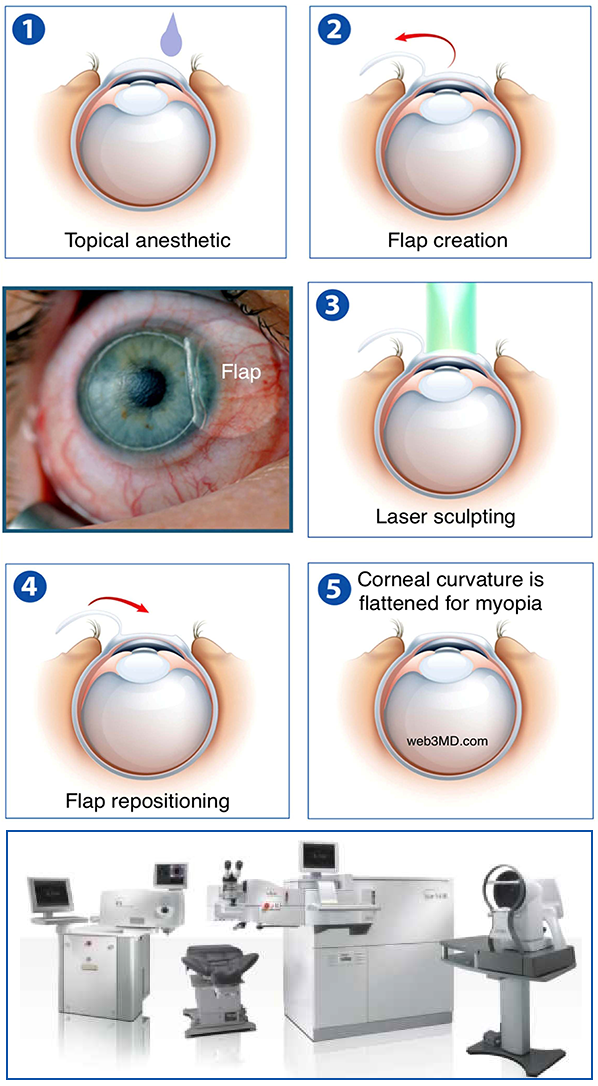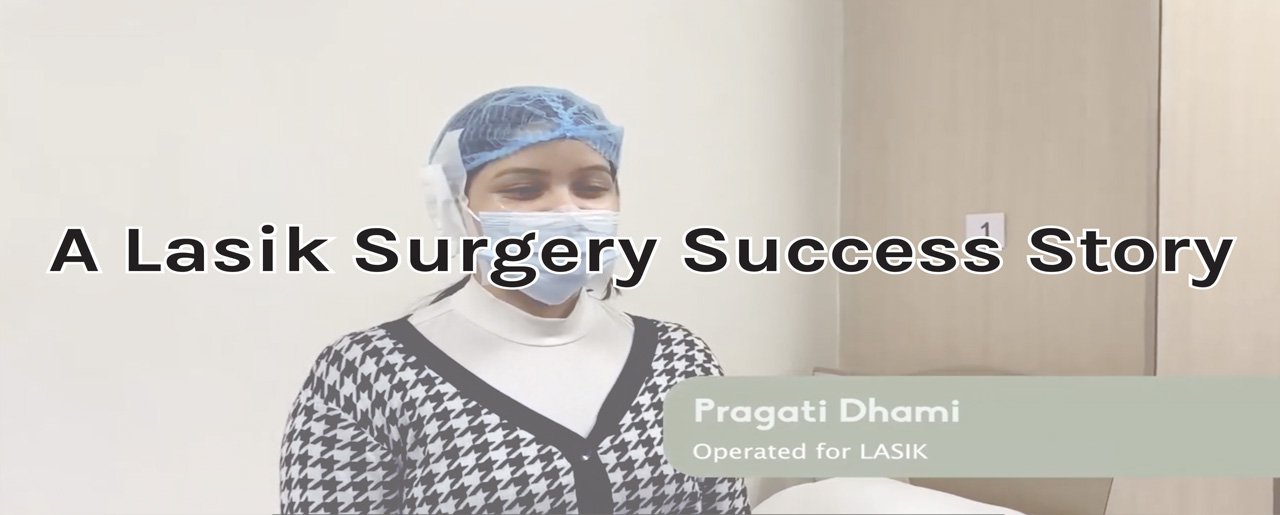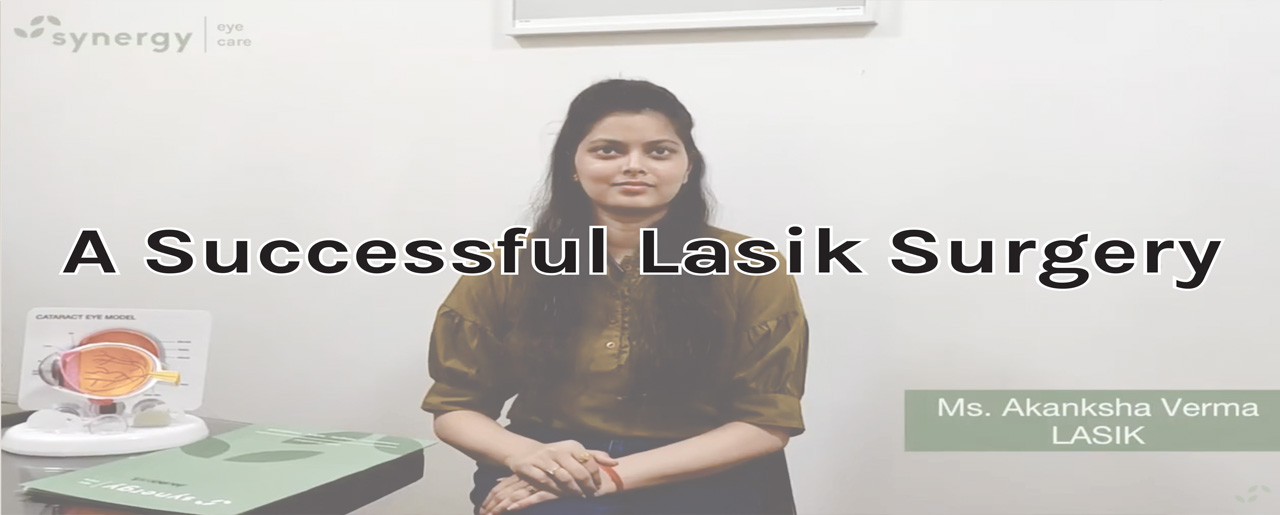Refractive Errors and LASIK laser
The eye works in a similar way as a camera. To get a
clear picture, the lens of the camera focuses the rays of
light on the camera film. In a similar way, the light rays
get focused on the Retina (the innermost layer of the
eye) with the help of Cornea (the anterior surface of the
eye) and lens of the eye. The inability of the eye to
accurately focus these rays of light coming from a
distance, onto the retina is called Refractive Error. This
condition may be either because the eye is too short or
long in length, or because the refractive power of the
cornea or lens is not optimum.
There are three types of refractive errors:
Myopia (near-sight): The light
rays are focused in front of the
retina, either because the eye is too
long or the power of the cornea and
lens is more than required. Distant
objects are blurred but the near
objects are seen clearly. Minus
glasses are needed to correct this
condition.
Hypermetropia (long-sight): The
light rays are focused behind the
retina, either because the eye is too
short or the power of the cornea and
lens is less than required. The
person may need to strain the eyes
to see objects clearly. Plus glasses
are needed to correct this condition.
Astigmatism: the light rays do not
get focused evenly to a point,
usually due to the cornea of the eye
being more curved in one direction
than the other. Cylinder lenses (with
axis) are needed.
What is Presbyopia?
In a younger person, the lens has the capacity to increase
its power to focus for nearer objects (accommodation).
Presbyopia is a part of normal aging process, where the
lens progressively loses this capacity of
accommodation. The distance vision may be normal, but the near vision becomes blurred with age greater than
about 40-45 years. This is corrected by wearing reading
glasses (plus) for the near work. One must remember that
refractive laser surgeries only correct the refractive error
(myopia, hypermetropia and astigmatism), but do not
correct the presbyopia.
What are the ways of treating refractive errors?
The refractive errors may be treated by either of the following ways
Glasses: This is the simplest and most popular way of correcting refractive errors
Contact lens: This option is cosmetically much
better. However, it requires thorough maintenance
and cleaning of the contact lenses, and regular eye
checkups. There is also a slight risk of allergy and
infection to the eye, if the contact lenses are not cleaned properly.
Refractive Laser Surgeries: Get rid of the need
for glasses and are increasingly becoming popular
with the advent of safer and more predictable laser
treatments.
What are the various Laser treatments available?
The most common options available are:
PRK: It is being used less commonly nowadays.
LASIK: This is the most popular form of Laser treatment.
SMILE: This is a new treatment option that is evolving.
What is LASIK?
LASIK involves raising a very thin corneal flap with the help
of a special automated and very precise blade. After this the
Excimer Laser treatment is applied to the rest of corneal
surface to change its shape and thus correct the refractive error.
The parameters used for conventional LASIK are based on the
refractive error of the patient. The raised flap is then positioned.
The bladeless Femto Laser (Intralase) LASIK raises a
very thin, precise and regular flap and is safer and gives
better quality of vision.
What is Customised and Aspheric LASIK?
These are special forms of LASIK in which the treatment
parameters are customised for the particular patient, based
not only on the refractive error, but also on the corneal map
of the eye and other findings detected by special tests. This
procedure tries to correct aberrations, maintains normal
aspheric shape of the cornea and gives better quality of
vision especially in dim light.
Who is a suitable candidate for LASIK laser surgery?
The person must be 18 years or older with a stable power. A
contact lens user must discontinue the use of contact lenses
preferably 2 weeks before the procedure. A detailed eye
checkup is done to look for suitability for the procedure.
Before the Laser is done the eyes are checked with special
machines to determine the exact power, the corneal mapping
is done and corneal thickness is measured. In patients with
high minus power, a special retinal checkup is done for
detecting any possible weak areas in the retina, which may
need to be treated before the LASIK is performed. The
LASIK laser is performed only after ruling out any
contraindication and confirming the suitability of the
procedure.
Is there any other option for patients not suitable for
LASIK?
In case the patient is not suitable for LASIK due to thin
cornea, other options like Phakic lenses, ICL, Clear lens
extraction with Multifocal IOL, PRK etc. may be considered
after detailed checkup.
What happens during the Laser surgery?
The LASIK surgery is done as an outpatient procedure and
does not require any admission. It is painless and is done
after putting the anesthetic drops and does not require any
injections. The laser procedure takes approximately 10-15
minutes for both eyes. After the procedure, the patient can go
back home after 20-30 minutes.
What are the complications of LASIK?
LASIK is a very safe procedure with a majority of patients
achieving very good results. However, since it is a surgical
procedure, it does carry some chances of complications as
well, which would be discussed with you before the surgery.
The overall rate of significant complications in LASIK is
only of the order of 1-2%. Some of these complications may
be:
• Undercorrection or Overcorrection
• Infection
• Glare and difficulty in night driving
• Scarring of the cornea
• Flap complications, perforation
What are the precautions to be followed after LASIK, and when can one resume work?
After LASIK surgery one needs to avoid using cosmetics in
and around the eye for a week or two. One should also avoid
wetting or rubbing the eyes for some period. Use the
medications regularly and report immediately in case of any
discomfort, redness, injury or any other problem. There is no
restriction in reading, watching TV, going for walks etc. In
majority of cases, routine office or simple household work
may be resumed in a day or two.
The Doctors of Synergy Eye Care give excellent results using the latest LASIK laser suite for Customised Blade less Femto HD iLASIK procedure, which is approved even for US Air Force Pilots and NASA Astronauts.
Disclaimer: Information published here is for educational purposes only and is not intended to replace medical advice. If you suspect that you have a health problem, please consult your doctor immediately





